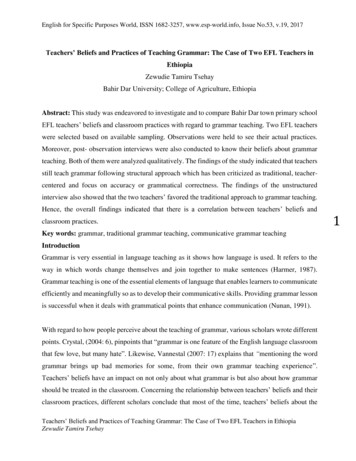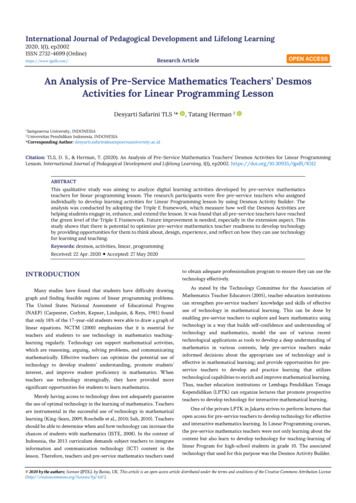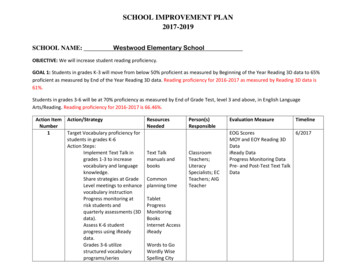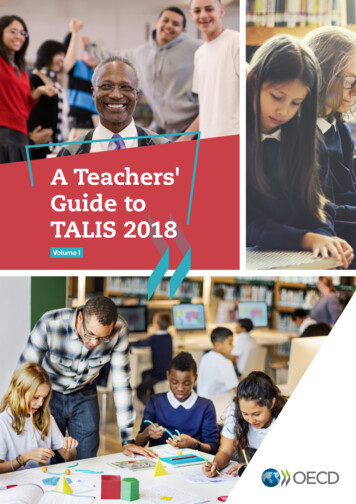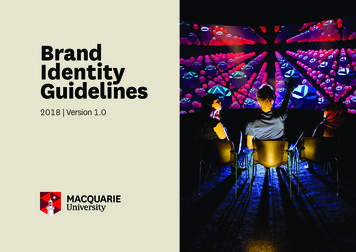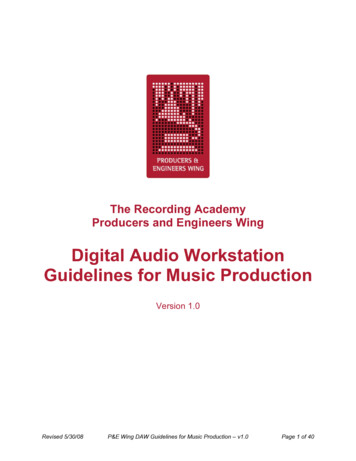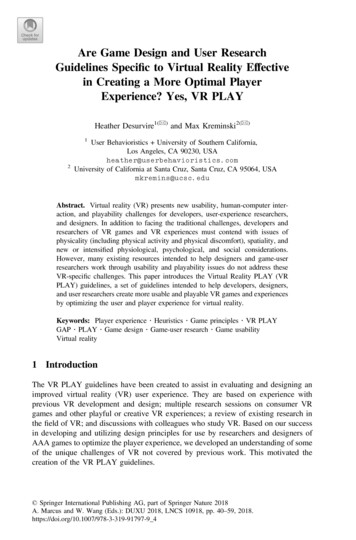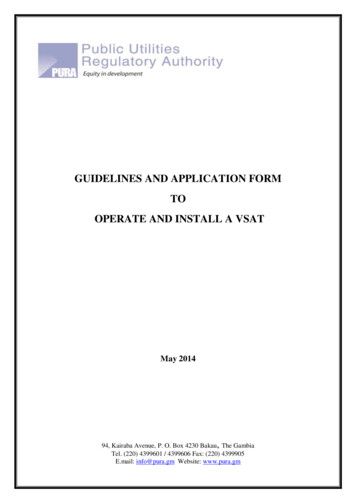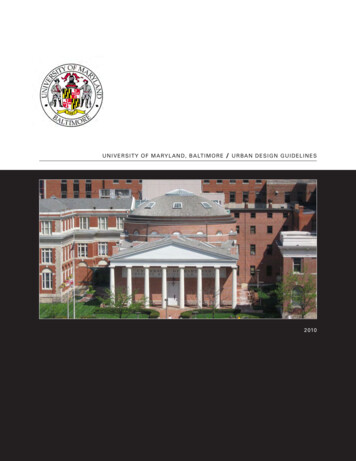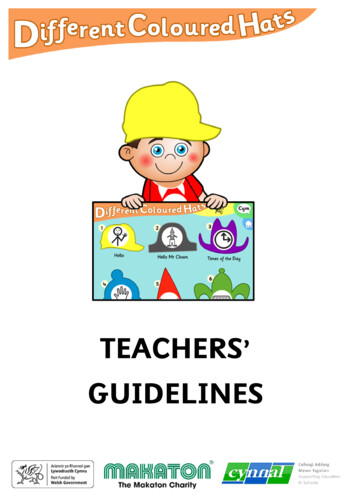
Transcription
TEACHERS’GUIDELINES1
This resource was developed by Music Therapists Mari Lloyd Pritchardand Elen ap Robert. It has been updated by Cynnal in partnershipwith The Makaton Charity and part funded by the Welsh Governmentas part of its Welsh and bilingual teaching and learning resourcescommissioning programme.Cwmni CYNNALPenralltCaernarfonGwyneddLL55 1BNTelephone: 01286 677686Email: adnoddau@cynnal.co.ukWebsite: - www.cynnal.co.ukCompany number : 3175443Charity number : 1065068The Makaton CharityWestmead HouseFarnboroughHampshireGU14 7LPTelephone: 01276 606760Fax: 01276 36725Email: info@makaton.orgWebsite: www.makaton.orgThe Makaton Charity is a Registered Charity No. 1119819Makaton is the registered Trade Mark of The Makaton Charity2
AcknowledgementsCynnal and The Makaton Charity are enormously grateful to themany people who have contributed in a wide variety of ways to thedevelopment and production of these materials.Mari Lloyd PritchardElen ap RobertNon ThwaiteMandy Hughes-Siwan MatthewsRhiannydd JonesSiân ThomasJenny RathboneElizabeth KnightDafydd IwanEryl DaviesEmyr ReesHugh Gwynne-Original authorOriginal authorRegional Makaton TutorInclusion Co-ordinator,Canolfan Addysg y BontALN Teacher, Ysgol TregannaALN Teacher, Ysgol TregannaSEN Advisory Teacher CeredigionThe Makaton CharityThe Makaton CharityCwmni Sain (Recording)Sound Engineer, Cwmni SainEditor / CD ProducerFormer Music Advisor, Cwmni CynnalOfficers and colleagues in the field of Special Educational Needs inGwynedd and Ynys Môn.Makaton symbols and signs used with permission from The MakatonCharity 2015 (www.makaton.org)3
CONTENTS1. About MakatonAbout the Makaton Programme2. How to Use this Different Coloured Hats ResourceUsing Makaton with singingUsing music and instrumentsUsing Makaton with English and with WelshThe User of Finger Spelling with MakatonFinger Spelling Chart (English)Finger Spelling Char (Welsh)691213141516173. The Songs, Activities and LyricsHello18Hello Mr Clown23Times of the Day31Holding Hands38What Do You See?43We’re Going on the Bus504
Clap Clap Clapping 1-2-356Sleeping and Awaking61Different Coloured Hats (Complete)68Who Wants to Play the Drum?75One Finger on the Drum80Quietly Play88Round and Round93Round and Round . . (and change)98Bang (Taro Taro)103Goodbye1084. Further information about The Makaton Charityand training1135
About MakatonAbout the Makaton ProgrammeMakaton is a unique language programme which uses signs, symbolsand speech to enable people to communicate. It supports thedevelopment of essential communication skills such as attention,listening, comprehension, recall and organisation of language andexpression.Makaton is used by learners and adults with a variety ofcommunication and learning difficulties. It is used extensively all overthe UK in pre-schools, schools, centres, hospitals and clinics, and in thehomes of people with communication and learning difficulties.In addition to the learners and adults with communication andlearning difficulties and the community around them - for example,teachers, health professionals, friends, public service bodies etc Makaton is increasingly used by the general public to aidcommunication. Makaton has been shown to be useful for all sorts ofpeople including those who struggle with understanding concepts,those who have poor literacy skills, including grammatical knowledge,and those with English as an Additional Language. By usingMakaton, learners and adults can take a more active part in life,because communication and language are the key to everything we doand learn.The Makaton symbols and signs are used with speech, the writtenword or on their own. They provide a visual representation of6
language which increases understanding and makes expressivecommunication easier.This multi-modal approach, where one mode facilitates another, hasbeen shown to increase opportunities for personal expression anddevelopment, participation in interaction and socialisation and toincrease access to education, training and public information.Using Makaton to help understanding and expressionThe main objective in using the Makaton programme is to encourage theunderstanding of speech and wherever possible to develop expressivespeech. Training is given on Makaton Workshops to develop signing skillsand symbols competence.The signs and symbols provide the basic concepts essential to everydaylife, on which additional, specialist vocabulary can be built upon and usedin conjunction with. The signs and symbols are intended to be usedinitially within structured teaching sessions. People with communicationand learning disabilities may at first have difficulty in understanding someof the more complex signs and require some explanation and teaching inorder to gain maximum value from their use.People with communication and learning disabilities can be furtherhelped if symbols are also used with signs. It is our recommendationthat you learn the signs and the symbols and use them together tosupport understanding and expression. As many signs outside of theCore Vocabulary may be unfamiliar to you and the person withlearning disabilities, it will be helpful to practise the signs and exploreways of explaining certain concepts in signs and symbols beforesharing them with the user.7
Above all, when using Makaton, remember Using Makaton is fun! Use signs and symbols as much and as often as you can. Always speak as you sign or use symbols. Offer lots of encouragement. Use signs and symbols to give praise to children for listening,speaking, signing, using symbols and any other form ofcommunication. Don’t give up! It may take a while but it is worth it in the end.If you would like more information about learning and using Makaton,please contact The Makaton Charity direct at http://www.makaton.orgor telephone 01276 606760.For more information about The Makaton Charity please see the endof this document.8
How to Use this DifferentColoured Hats ResourceThis resource is designed by Cynnal in partnership with The MakatonCharity to support access to the Different Coloured Hats resourceusing Makaton. It is a new version of the original Different ColouredHats resource which was prepared and designed by Mari LloydPritchard and Elen ap Robert, who are both qualified MusicTherapists. Music Therapy is a specialist area, dealing directly withthe relationship between music and the development of the child. TheDifferent Coloured Hats resource was not designed as a music therapyhandbook, but rather a compilation of musical activities by the twotherapists and based on their experience with children. The packageaims to encourage and address directly the development ofcommunication skills for children with the hope that users of theresource will discover useful ideas to use, benefit from and enjoy.This new Different Coloured Hats resource builds on the originalresource to aid the development of language and communication skillsby using Makaton together with the songs and activities provided.This resource is designed to be used by teachers, parents and carers tohelp children and young people who have speech, language andcommunication needs (SLCN). It will also be useful to those who arelearning Welsh or English as an alternative language.Some young people have SLCN that can impact on their ability tolisten, understand and express themselves. The activities in thisresource are designed to support these three areas of communicationusing Makaton symbols and signs.9
A range of specific symbols and signs are provided to help you to useMakaton with the activities, however it is assumed that you alreadyhave a basic knowledge of the Makaton Core Vocabulary symbols andsigns, the starting vocabulary of the Makaton Language Programme.The Makaton vocabulary in Different Coloured Hats is taken frompublished resources including the Makaton Core Vocabulary, NationalCurriculum and other Resource Vocabulary topics. You can use thesigns and symbols with the songs that are part of Different ColouredHats in activities associated with the songs and in everyday activities.10
The resource briefly consists of these pages:Click here for theTeachers’ GuidelinesClick here to go to theMain PageTo choose a song, clickon one of the hats.Song plays on this screen.Click here to see list ofsigns specific to the chosensong.To see all the Makatonsymbols, click here.Click on the symbol to seeit being signed.Click on the hats to see itbeing signed.11
Using Makaton with singingUsing Makaton with singing is a fun and easy way to learn to usesigns for your child, nursery or school. Signing and singing have bothbeen shown to encourage the development of communication andlanguage skills and are beneficial for vocalisation, confidence, socialskills, emotional development, well-being and self-esteem. UsingMakaton with singing is also a great way to include children of allabilities within the singing and music. Here’s some tips to help you touse Makaton with singing: Use the songs flexibly, to focus on the item of vocabulary thatyou want your child to learn. You don’t have to make all thesigns for each song. It is OK just to make one or two signs tohelp children to understand and express themselves.Use the symbols that are provided to help children who areunable to vocalise to take part in other ways, for example byconducting the music, by choosing which verse to sing next orsimply to allow children to choose which song they would like tosing.Try to learn the signs yourself so that you are confident in usingthem and can do so without referring to the book or the video.Singing songs also helps children to develop communicationskills, including vocalisation, language skills, turn taking. Singingsongs has also been shown to contribute to the development ofconfidence, self-esteem, social skills, well-being, emotions andalso to help develop singing and musical skills. Many of theseoutcomes are the same as for using Makaton.Together, the benefits of using Makaton whilst singing are verypowerful:12
Emphasising the important words:using pitch, volume (sound) - facial expression, body movementthrough volume (sound) and pace – vary the speed of the songand the signs, facial expression, body language and movement,size of the sign and body size (‘Quiet’ v. ‘Loud’) Emphasise meaning – using signs Signs can help to add meaning too, and can be adapted to fitwith the speed of the music, the volume of the song by makingthe sign smaller or larger, etc. Encourage looking – attraction of signs and symbols Encourage listening – sounds Encourage turn taking – call and response, singing rounds,interaction Vocal play – making noises and vocalising sounds Rhythm and patterns – use ‘Again’, repeated use of one signwithin a song etc. and also to allow everyone to take part.In this resource, within the song lyrics the words that are signed areunderlined. On the video the signed words are in green.Using music, instruments and propsWhen singing songs and using signs, you may find that standardmusic tracks go too fast so be prepared to slow the music down. Useinstruments to help maintain a steady beat. Make sure you pitch thesong appropriately for the children and use the pitch to set the key orstarting point for the song. You may also like to use a musicalgreeting or a symbol to denote whose turn it is.Instruments, objects, toys, photos, dressing up clothes etc are all goodways of involving and motivating children. The Gathering Drum isextremely effective for all sorts of drumming activities and is a very13
effective tool in general. This type of drum, having a large surfacearea, is the most useful.Symbols are also a good way of involving and motivating children.Children can use these to choose the next verse, direct the group, stopand start the music, and can take part by playing instruments.Once the songs are familiar, adapt them with different words foranother setting.Using Makaton with English and with WelshThe principles of using Makaton with English are the same as withWelsh, to support understanding and expression of the spokenlanguage. You must always speak when using Makaton - Because thesigns follow the spoken word order, the order of the signs used withWelsh may differ from the order of the signs used with English.However the sign will be the same regardless of whether the English orWelsh word is spoken. This ensures consistency and standardisationfor everyone.You will find within this resource however that there are differences insome of the songs between the lyrics for the English version and thelyrics for the Welsh version. This is deliberate and affords you theopportunity to expand your own Makaton vocabulary of signs andsymbols.14
The Use of Finger Spelling with MakatonIn the Makaton Language Programe, finger spelling is kept to theminimum because finger spelling depends on spelling ability. In someof the songs you may want to refer to the children in your group byname.Finger spelling is useful for naming. Rather than spelling out thewhole name, in Makaton it is appropriate to spell only the initialletters of a person’s name, for example, for ‘Peter’ finger spell ‘P’, for‘Mr Jones’ finger spell ‘J’ . If you have two children in the same groupwhose names start with the same letter, you can add another sign todifferentiate, for example Sarah with brown hair, Susan with blueeyes.This same method of finger spelling the initial letter can be used toname places, eg ‘Kitchener Road’.Finger spelling for both English and Welsh is provided – the charactersthat are the same have the same fingerspelling sign.Although we have used letter names in this resource, remember thatthe phonetic sound of the letter could also be used.15
Finger Spelling Chart (English)ABCDEFGHIJKLMNOPQRSTUVWXYZ16
Finger Spelling Chart (Welsh)ABCCHDDDEFFFGNGHIJLLLMNOPPHRRHSTTHUWY17
HelloUsing Makaton Saying hello is a useful activity to encourage basic communicationskills such as eye contact. Practice fingerspelling the names of those in the group so you areconfident. Although we have used letter names here, remember that thephonetic sound of the letter could also be used. Remember to have fun.Aims: Self-awarenessAwareness of othersTo indicate ‘beginning’Equipment:Symbol cards for HelloGuidance: Everybody – children and adults – sit in a circle.Choose a child to start the activity and give him/her a symbolcard to indicate that it is his/her verse.Sing the verse, putting the child’s name in the gap. Repeat theverse to the child as needed. (Some children will need to hear their18
verse more than once, in order to encourage and develop selfawareness.)Encourage the child to pass the symbol to the next child in thecircle. Give the child plenty of time to do this independently. It istotally acceptable to have pauses in the song.Suggestions: Use this song at the beginning of a music session or at thebeginning of the day.Select a small instrument which is easy to grasp and pass on e.g.hand chimes or tambourine.Use an object e.g. soft toy, hat or makaton card to pass on.Place a drum in the middle of the circle and pass a beater on.After establishing the pattern of passing on around the circle, thefirst child could choose another child to receive the symbol andtake a turn (not necessarily the person next to them). It is OK ifsome children have more than one turn.19
HelloHello Jack hello helloHello Jack hello helloHello Jack hello helloHello hello hello.Hello Laura hello helloHello Laura hello helloHello Laura hello helloHello hello hello.Hello Alister hello helloHello Alister hello helloHello Alister hello helloHello hello hello.Repeat as necessary20
Makaton SignsMake sign atshoulder heighthello21
Makaton Symbolshello22
Hello Mr ClownUsing Makaton Remember, using body language and facial expression is importantwhen making signs for emotions (see the video). Encourage children to talk about how they feel, using the signsand symbols as often as you can. Use signs and symbols for Good to praise and encourage thechildren.Aims: Awareness of othersEncourage choosing – with the eyes/by pointingAwareness of emotionExpressing emotionTaking turnsEquipment: Soft toySymbol cards for the emotions happy, sad, angry, tiredGuidance: Everybody – children and adults – sit in a circle.Set the face cards where everybody can see them.23
Give each of the children a soft toy to indicate that it is his/herverse, and start the activity.Sing the chorus (Hello Mr Clown) at a steady beat and fairlylively.Pause before asking the child “How does Mr Clown feel today?”Give the child enough time to select one of the cards. It is OK tochoose the same card more than once. The child can choose bylooking, making a gesture or by pointing.Sing the song (“I’m feeling ”) with the words which correspond tothe child’s choice. Remember to reflect the emotion in your facialexpression and body language. Encourage the children to do thesame.Suggestions: Change the soft toy and adapt the words e.g. “Hello Mr Ted ”Begin by offering two face cards and extend the choice gradually.Exclude the cards and let the child choose an emotion.Consider ending the activity by choosing yourself for the lastverse; you can then select a happy face to convey a sense ofsecurity to finish the activity.24
Hello Mr ClownChorus:Hello Mr Clown, hello Mr ClownHello, how are you?Hello Mr Clown, hello Mr ClownHello, how are you?“How are you feeling today Mr Clown?”Verse 1:I’m feeling happy, happy, happy,I’m feeling happy, happy, happy,I’m feeling happy,Feeling happy today.Chorus:Hello Mr Clown, hello Mr ClownHello, how are you?Hello Mr Clown, hello Mr ClownHello, how are you?“How are you feeling today Mr Clown?”Verse 2:I’m feeling sad, sad, sad,I’m feeling sad, sad, sad,I’m feeling sad,Feeling sad today.Chorus:Hello Mr Clown, hello Mr ClownHello, how are you?Hello Mr Clown, hello Mr ClownHello, how are you?25
“How are you feeling today Mr Clown?”Verse 3:I’m feeling cross, cross, cross,I’m feeling cross, cross, cross,I’m feeling cross,Feeling cross today.Chorus:Hello Mr Clown, hello Mr ClownHello, how are you?Hello Mr Clown, hello Mr ClownHello, how are you?“How are you feeling today Mr Clown?”Verse 4:I’m feeling tired, tired, tired,I’m feeling tired, tired, tired,I’m feeling tired,Feeling tired today.26
Makaton SignsMake sign atshoulder heightHand moves downslightlyClawed hand twistsover nosehelloclownFlat hands move up chestthen make ‘Very Good’sign away from bodyhow are youIhappysad27
Makaton SignsShow tension in hands. Useone or both hands as relevantcrossShoulders sag to showdegree of tirednesstiredtoday28
Makaton Symbolsclownhellohow are youtodayIhappy29
Makaton Symbolssadcrosstired30
Times of the DayUsing Makaton Use songs at key times of the day for everyday activities, such asplay time, lunch time, tidy up time. Make a symbol chart showing the activities for the day, takingaway each one as it is completed so everyone can see what’scoming next. You can use the sign for House instead of the sign for Home. Going home time can be a good one to lead into saying’Goodbye’.Aims: Awareness of the pattern of the daySupport understanding of languageEquipment:Symbol cards of the routine activitiesGuidance: Use this short simple melody often during the day, varying thewords according to the situation. This is done in order to drawattention to events and specific activities in the day’s pattern.Repeat the verse a number of times to establish the event oractivity.31
Suggestions: For example “Drink Time”: continue to sing until everybody issitting down to have a drink. Be prepared to use this song in response to an unexpected orunusual event by improvising words which refer to it.32
Times of the DayIt’s drink time, it’s drink time,Now come and sit down.It’s drink time, it’s drink time,Now come and sit down.It’s play time, it’s play timeIt’s time to play.It’s play time, it’s play timeIt’s time to play.Tidy up time, tidy up timePut the toys in the box.Tidy up time, tidy up timePut the toys in the box.Going home now, going home nowIt’s time to go home.Going home now, going home nowIt’s time to go home.These are only a few exam ples of suitable tim es / events w hich couldbe used as the focus for this song.33
Makaton SignsTap twiceEmphasise movement –tilt head backwardsslightlytimeto drinkto cometo sit downto playto tidy up34
Makaton SignsWhole formation circlestwicetoysboxSmall arced movement –direction can be varied tosuit contextto gohomeSmall quick downwardmovementnow35
Makaton Symbolstimeto drinkto cometo sit downto playto tidy up36
Makaton Symbolstoysboxto gohomenow37
Holding HandsUsing Makaton The signs for Up and Down practice pointing. Use signs and symbols as much and as often as you can. Remember to have fun.Aims: Awareness of othersAnticipationReinforce languageLarge movementsGuidance: Everybody – children and adults – sit in a circle. Everybody holding hands. Everybody to move their hands down to the floor and then uphigh in the sky in accordance with the words and shape of themelody. Obvious pause on “Ready ” and “down on the floor ” to reinforceand underline the feeling of anticipation. Pause to reinforce both poles: up and down, high and low. Repeat as required. If a child expresses a desire to re-start theactivities by moving their hands down, then you should respondto the sign and repeat the song.38
Suggestions: It is possible to stand – possibly on tip toes, and in the same way leandown to reinforce the meaning of the words. The range of physicalmovements that may be used is dependent on the needs of those in thegroupRather than hold hands, children can hold onto a long piece of string andcreate a circle, or hold a hula hoop.“Holding Hands” can be omitted and “All Together” can be used instead39
Holding HandsHolding hands, holding hands, holding hands ready.and . . .Down on the floor.Down on the floor and up we go,Up and up and up we go.and . . .Down on the floor.Down on the floor and up we go,Up andUp . . .And down again!40
Makaton SignsThumbs tap sides ofchest twiceholding handsreadySmall sign, in eitherdirection, to suit flowof other signsanddownPoint down before signfloorup41
Makaton Symbolsholding handsreadyanddownfloorup42
What Do You See?Using Makaton Naming body parts is an important skill. Use the sign for What as much as you can, so the children canexperience and practice answering. Adapt this song to practice naming objects.Aims: Self-awareness Awareness of others Encourage eye contact Encourage listening skills Encourage pointing skills Encourage language – labelling skillsEquipment:Symbol cards for body partsGuidance: Sit face to face with an individual or in a circle if in a group.Sing the song steadily encouraging everybody to listen.Encourage eye contact in the first part of the song “Look at me,what do you see?” and use a sign or a gesture on “look” toreinforce the word and to draw attention.43
When you reach “do you see nose”, for example, the singing mustbe slowed down in order to provide enough time to show the“nose”, and to give children an opportunity to point to their“nose”.Repeat the verse over and over.Suggestions: Start with only 2 or 3 parts of the body and use them regularlyuntil they have been ‘established’. Then move on to extend thenumber of body parts.Give the child an opportunity to choose a body part.It is important to give the child time to point independently.44
What Do You See?When you look at me what do you see?When you look at me what do you see?Look at my nose.Look at my nose, nose,Look at my nose, nose, nose.When you look at me what do you see?When you look at me what do you see?Look at my hand.Look at my hand, hand,Look at my hand, hand, hand.When you look at me what do you see?When you look at me what do you see?Look at my arm.Look at my arm, arm,Look at my arm, arm, arm.When you look at me what do you see?When you look at me what do you see?Look at my knee.Look at my knee, knee,Look at my knee, knee, knee.45
Makaton SignsTwo fingers areslightly apart‘M’ hand toucheschestto lookmewhatto seeTap with finger tips ofwhole hand. Touch bothknees for pluralRight index fingertouches tip of nosenoseknee46
Makaton SignsTouch back of right or lefthand as appropriate. For pluraltouch back of both handshandsWith finger tips touchappropriate part of armarm47
Makaton Symbolsto lookmewhatto seenoseknee48
Makaton Symbolshandsarm49
Going on the BusUsing Makaton Remember to speak as you sign or use symbols. Offer lots of encouragement and use signs and symbols to givepraise. Adapt this song with other modes of transport. To show driving in the car, bur or train, move the sign for car,bus, or train forward (see video).Aims: Awareness of the day’s patternUnderstanding of language (ways of travelling)Creative playEquipment:Make symbol cards or pictures of a train, car, bus etc.Guidance: Allow members of the group to select which verse to sing nextwith symbol cards. As you sing the song, the group can move around the roomimagining that they are in a train, car etc. Use the song to prepare for an event that involves going on a bus,going on a train, car etc. Sing the song while you are on the bus, train, car etc.50
Going on the BusWe’re going on the bus, we’re going now.Going on the bus, we’re going now.Bus, bus, going on the bus.Come on the bus with me.(repeat)We’re going in the car, we’re going now.Going in the car, we’re going now.Car, car, going in the car.Come in the car with me.(repeat)We’re going on the train, we’re going now.Going on the train, we’re going now.Train, train, going on the train.Come on the train with me.(repeat)51
Makaton Signsbusto goMime driving vehicleforwardto drive a busto comeMime driving vehicleforwardcarto drive a car52
Makaton Signs‘M’ hand toucheschestmetrainmove sign forwardto drive a train53
Makaton Symbolsbusto goto drive a busto comecarto drive a car54
Makaton Symbolsmetrainto drive a train55
Clap Clap Clapping 1-2-3Using Makaton Use the sign Clap to match the syllables and the beat of the song. Remember to have fun. Use signs and symbols for Good to praise and encourage thechildren.Aims: To listen and concentrateAwareness of othersCounting skillsHand-eye co-ordinationAwareness of silenceEquipment:Symbol cards for Clap and StopGuidance: Everybody – children and adults – sit in a circle. The circle could be rotatedso that everybody sits ‘face to back’ and gently taps the back of the personin front.Hold the first “O-o-oh-” for a while in order to draw attention and to tryand create eye contact.Emphasise the word “Stop!” every time;a) with a strong accentb) with obvious body gesturec) by tapping your lap on the word “Stop!”56
Members of the group could be encouraged to close their eyes during thisactivity. Remember that if they have their eyes closed they won’t be able tosee the signs. You may need to think of another way to get their attention‘wake up’ again.57
Clap Clap Clapping 1-2-3Oh! Clap clap clapping 1 - 2 - 3Oh! Clap clap clapping 1 - 2 - 3Oh! Clap clap clapping 1 - 2 - 3Oh! Clap clap clap and lapandandandandstop.stop.stop.stop.Oh! Clap clap clapping 1 - 2 - 3Oh! Clap clap clapping 1 - 2 - 3Oh! Clap clap clapping 1 - 2 - 3Oh! Clap clap clap and lapandandandandstop.stop.stop.stop.Repeat as necessary58
Makaton Signsclap handsstop12359
Makaton Symbolsclapstop12360
Sleeping and AwakingUsing Makaton Be aware that when people have their eyes closed they can’t seethe signs. Slow down your signs to emphasise being tired and add moreenergy to wake up. Use signs and symbols to give praise and encourage the children.Aims: Self-awarenessEncourage listening skillsEncourage anticipation skillsEncourage creative playEquipment:A selection of instruments and soft toysSymbol cardsGuidance: Everybody – children and adults – sit in a circle.The song is sung steadily encouraging everybody to listen. It is a goodidea to create a quiet atmosphere when singing the opening part of thesong, and encourage everybody to close their eyes and pretend that theyare sleeping.61
Pause before the last line in order to create a feeling of anticipation andthen wake everybody up by singing the last line “wake up, wake up now” loud and lively.Repeat the verse over and over.Suggestions: A loud instrument can be used to wake everybody up at the end, forexample whistle/ horn/ drum/ tambourine.Soft toys may be used as ‘props’. It is possible for each child to have a softtoy and to pretend that the toy is sleeping, or that they are sleepingtogether with the toy.The leader can use a hand puppet to lead the activity.62
Sleeping and AwakingI’m feeling tired, I’m very tired.It’s time to close my eyes.Oh! Everybody close your eyes, and . . .Wake up, wake up now.Oh! I’m feeling tired, I’m very tired.It’s time to close my eyes.Oh! Everybody close your eyes, and . . .Wake up, wake up now.63
Makaton SignsShoulders sag to showdegree of tirednessItiredTap twicetimeIndex and thumb showeyes closingto close eyesIndex fingers and thumbsspring openeverybodyto wake up64
Makaton SignsSmall quick downwardmovementnowEyes closedto sleep65
Makaton SymbolsItiredtimeto close eyeseverybodyto wake up66
Makaton Symbolsnowto sleep67
Different Coloured HatsUsing Makaton Practice fingerspelling names and colours so you are confident. In this song the sign for ‘ware’ denotes ‘wearing a hat’. Use signs and symbols as often as you can. Although we have used letter names here, remember that thephonetic sound of the letter could also be used.Aims: Self-awarenessAwareness of othersCopying/simulating skillsIdenti
and the signs, facial expression, body language and movement, size of the sign and body size (‘Quiet’ v. ‘Loud’) Emphasise meaning – using signs Signs can help to add meaning too, and can be adapted to fit with the speed of the music, the volume of the song by
